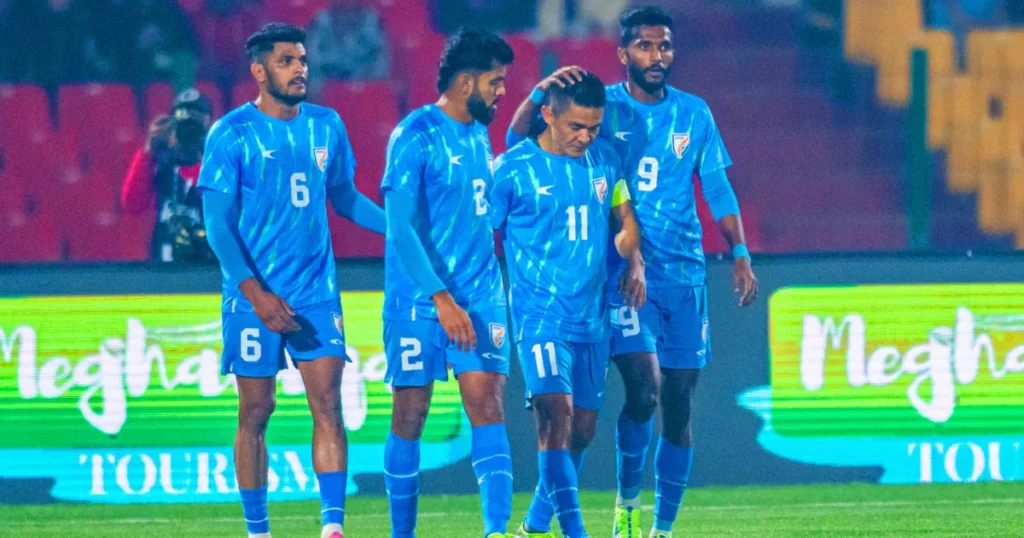Football in India isn’t just a sport—it’s a heartbeat. From the dusty pitches of Kolkata to the lush green fields of Goa, the India national football team, affectionately known as the Blue Tigers, has captured the imagination of millions. In a country where cricket reigns supreme, the India football team stands as a symbol of resilience, unity, and unyielding spirit. Whether you’re a die-hard supporter waving the tricolor at a packed stadium or a casual fan tuning in for the next big match, the story of the Blue Tigers is one of triumphs against the odds, heartbreaking near-misses, and a relentless push toward global recognition.
This article dives deep into the world of the India football team, exploring its rich history, standout achievements, iconic players, evolving tactics, the latest results that have fans on edge, what’s next on the calendar, the electric fan culture that’s fueling the fire, and a bold look at the future. If you’ve ever wondered about the India FIFA ranking or caught yourself googling the India next match, buckle up. We’re about to take you on an engaging ride through the beautiful game, Indian style.
The Roots: A Glimpse into the History of the India Football Team
The tale of the India football team begins in the early 20th century, a time when the sport was introduced by British colonial rulers. The All India Football Federation (AIFF) was founded in 1937, but India’s football journey truly kicked off in the post-independence era. Picture this: 1950. The Blue Tigers qualify for the FIFA World Cup finals—the only time they’ve done so. Drawn against powerhouses like Sweden, Italy, and Paraguay, India was set for a historic debut in Brazil. But controversy struck. Rumors swirled about FIFA’s barefoot ban (though historians debate this), and with financial hurdles and a preference for the Olympics, India withdrew. It was a missed opportunity that would haunt the team for decades.
The 1950s and 1960s, however, marked the “Golden Era.” Under legends like captain Prasanta Banerjee and coach Syed Abdul Rahim, India dominated Asia. At the 1951 Asian Games in New Delhi, they clinched gold, defeating Iran 1-0 in the final—a feat repeated in 1962 in Jakarta. These victories weren’t flukes; India reached the semi-finals of the 1956 Melbourne Olympics, finishing fourth overall after a heartbreaking 0-1 loss to Yugoslavia. Gostha Pal, the “Wall of China” for his impenetrable defending, and Sailen Manna became household names, inspiring a generation.
The 1970s and 1980s saw ebbs and flows. India won gold at the 1987 South Asian Games, but global inconsistencies crept in. The 1990s brought revival with the inaugural SAFF Championship win in 1993, led by a young Bhaichung Bhutia. Yet, by the early 2000s, the team languished outside the top 150 in the India FIFA ranking, plagued by administrative issues and limited international exposure.
The turning point? The 2010s. The launch of the Indian Super League (ISL) in 2014 injected professionalism, foreign talent, and massive investment. Coaches like Stephen Constantine brought structure, and suddenly, the Blue Tigers were unbeaten for 18 months from 2016 to 2018. This era saw India qualify for the 2019 AFC Asian Cup after an eight-year absence—a moment that reignited national pride. Today, as of November 2025, the India FIFA ranking sits at 136th, a dip from peaks but a foundation for climb-back stories. The history of the India football team isn’t linear; it’s a testament to perseverance in a cricket-dominated landscape.
Glory Days: Major Achievements That Defined the Blue Tigers
What makes the India football team tick? It’s those unforgettable highs that echo through stadiums and social media. Let’s spotlight the major achievements that have etched the Blue Tigers into Asian football lore.
First, the Asian Games golds of 1951 and 1962 remain crowning jewels. In 1951, a 1-0 win over Iran in front of 30,000 roaring fans in Delhi showcased India’s flair—barefoot players outmaneuvering suited opponents. The 1962 triumph in Jakarta, defeating South Korea 2-0, solidified India’s status as Asia’s best, predating the AFC Asian Cup.
Regionally, the South Asian Football Federation (SAFF) Championship is India’s playground. They’ve won it eight times: 1993, 1997, 1999, 2005, 2009, 2011, 2015, and most recently in 2023. That 2023 victory, a 1-0 final win over Kuwait, was pure drama—Lallianzuala Chhangte’s 87th-minute strike sending fans into frenzy.
On the continental stage, qualifying for three AFC Asian Cups (2011, 2019, and 2023) marks progress. The 2019 edition in the UAE was special: India held Bahrain to a 0-0 draw and lost narrowly to Thailand (1-4) and UAE (0-2), but the mere presence boosted the India FIFA ranking to a 21-year high of 96th in 2017.
Other feathers? The 2003 Afro-Asian Games silver, where India stunned Zimbabwe 5-3 before falling 0-1 to Uzbekistan. And in 2023, the Intercontinental Cup and Tri-Nation Series wins showcased depth. These aren’t just trophies; they’re milestones that prove the India football team can punch above its weight. As fans chant, “Bharat Mata Ki Jai,” each achievement feels like a step toward the stars.
Stars on the Pitch: Key Players Who Lit Up the Jersey
No team story is complete without its heroes. The India football team has been blessed with players who transcend the game—warriors who score, defend, and inspire.
At the forefront is Sunil Chhetri, the eternal captain. With over 150 caps and 94 goals (as of 2025), he’s India’s all-time leading scorer, outpacing even legends like I.M. Vijayan. Chhetri’s leadership shone in the 2019 Asian Cup and his hat-trick in a 4-0 rout of Nepal in 2023. Even in his late 30s, his return to the squad in 2025 added veteran steel—think of his poised finish in the 3-0 Maldives win.
Then there’s Bhaichung Bhutia, the “Sikkimese Sniper.” The first Indian to play professionally in Europe (with Bury FC), Bhutia’s 42 goals in 107 caps (1995-2011) paved the way for pros like Gurpreet Singh Sandhu, India’s No. 1 keeper with over 80 caps and heroics in the 0-0 Qatar draw during 2022 World Cup qualifiers.
Emerging stars? Sandesh Jhingan anchors the defense with his no-nonsense tackling—key in the 2023 SAFF triumph. Midfield maestro Anirudh Thapa orchestrates attacks with vision, while young winger Lallianzuala Chhangte dazzles with speed, netting winners in high-stakes games. And don’t sleep on Apuia (Lalengmawia): his box-to-box energy is the engine room’s heartbeat.
These players aren’t just athletes; they’re cultural icons. Chhetri’s motivational social media posts rally youth, while Bhutia’s post-retirement advocacy for the sport keeps the flame alive. In the India football team, stars aren’t born—they’re forged in passion.
Mastering the Game: Tactics and Strategies of the Blue Tigers
Tactics win battles, and the India football team has evolved from chaotic flair to calculated precision. Early days favored the “Indian style”—dribbling wizards like Chuni Goswami bamboozling defenses with barefoot brilliance. But post-2000, structure became key.
Under Stephen Constantine (2015-2019), a 4-2-3-1 formation emphasized solidity: two holding mids shielding a back four, with wingers stretching play. This unbeaten run? Credit defensive discipline—India conceded just five goals in 11 wins. Igor Stimac (2019-2024) shifted to possession-based 4-3-3, focusing on fitness and high pressing, though results were mixed amid the pandemic.
Enter Manolo Marquez in 2024: the Spaniard blended tiki-taka with Indian hustle, prioritizing quick transitions. His 3-0 Maldives thrashing? A masterclass in counter-attacks. Now, with Khalid Jamil as the first Indian head coach since 2012 (appointed August 2025), expect a homegrown twist: adaptive 4-4-2 for regional games, emphasizing youth integration and set-piece prowess.
Challenges remain—stamina against Asian powerhouses like Japan, tactical fouls in qualifiers. But with AIFF’s focus on analytics and foreign training camps, the Blue Tigers are tactically sharper. It’s not just about the formation; it’s mindset. As Jamil says, “Football is 90% mental.” The India football team is learning to think like winners.
On the Scoreboard: Recent Results and the Road So Far in 2025
2025 has been a rollercoaster for the India football team—a mix of grit, glitches, and glimmers of hope. Kicking off under Marquez, the year started with promise but soured quickly.
In March, a morale-boosting 3-0 friendly win over Maldives—goals from Rahul Bheke, Liston Colaco, and a vintage Chhetri—hinted at revival. But June brought jolts: a 0-2 friendly loss to Thailand exposed defensive frailties, followed by a shocking 0-1 defeat to Hong Kong in AFC Asian Cup qualifiers. Marquez parted ways, and Sunil Chhetri’s surprise recall couldn’t stem the tide.
August’s CAFA Nations Cup was a silver lining. Invited as guests, India, now under Jamil, stunned with a 2-1 group win over Tajikistan—their first in 17 years. They topped the group but fell in semis; a 1-1 draw with Oman went to penalties, securing third place via a 3-2 shootout win. Solid, but not spectacular.
October’s AFC Asian Cup qualifiers were brutal. Hosting Singapore on the 9th ended in a 1-1 draw—frustrating after leading. The away leg on the 14th? A 1-2 loss, eliminating India from 2027 contention. As of November 4, 2025, the India FIFA ranking has slipped to 136th, the lowest since 2016, with 1,113 points after four games: one win, one draw, two losses.
These results sting, but they teach. Goal droughts (just five scored in 2025) highlight finishing woes, yet clean sheets against Tajikistan show defensive growth. Fans are vocal—social media buzzes with calls for more youth blood. The Blue Tigers aren’t broken; they’re battle-tested.
To help you track the highs and lows, here’s a handy table summarizing the India football team’s 2025 results so far. It’s designed for quick insights, letting you see patterns at a glance and better understand the season’s narrative.
| Date | Opponent | Competition | Result | Scorers/Notes |
|---|---|---|---|---|
| March 19 | Maldives | Friendly | 3-0 W | Bheke, Colaco, Chhetri |
| June 4 | Thailand | Friendly | 0-2 L | Defensive lapses key |
| June 10 | Hong Kong | AFC Asian Cup Qualifier | 0-1 L | Elimination blow |
| Aug 29 | Tajikistan | CAFA Nations Cup | 2-1 W | First win vs them in 17 years |
| Aug 31 | Oman | CAFA Nations Cup (3rd place) | 1-1 (3-2 pens) W | Bronze secured on shootout |
| Oct 9 | Singapore | AFC Asian Cup Qualifier | 1-1 D | Home draw, missed chance |
| Oct 14 | Singapore | AFC Asian Cup Qualifier | 1-2 L | Away loss, qualifiers over |
This table underscores the inconsistency—wins in friendlies and minors, but qualifier woes. Use it to spot trends: stronger at home, vulnerable on counters. It’s your cheat sheet to debating with fellow fans over chai.
Eyes on the Horizon: Upcoming Fixtures for the Blue Tigers
Excitement builds as the India next match looms large. On November 18, 2025, the Blue Tigers face Bangladesh in an away AFC Asian Cup qualifier at Sylhet District Stadium. It’s a rivalry reborn—India’s winless streak against Bangladesh in recent years adds spice. A victory here could spark a ranking rebound and morale boost.
Looking ahead, December might bring friendlies or SAFF U-17 commitments, but the focus shifts to 2026 World Cup qualifiers resuming in March. Potential clashes with powerhouses like Qatar or UAE will test Jamil’s squad. Youth internationals, like the U-20 AFC Asian Cup qualifiers in mid-2026, feed the pipeline.
Mark your calendars: the India next match isn’t just a game; it’s a statement. With Chhetri’s guile and young guns firing, expect fireworks. Will it be the turning point? Only time—and 90 minutes—will tell.
The Roar from the Stands: Fan Culture Fueling Indian Football
What sets the India football team apart? Its fans. From the scattered supporters of the 1990s in West Bengal, Kerala, and the Northeast to today’s organized legions, fan culture is the secret sauce.
Enter the Blue Pilgrims, founded in 2017 during the U-17 World Cup. This Kolkata-based ultras group travels en masse, unfurling massive tifos of tigers and tricolors. Their chants—”Ole Ole, Blue Tigers!”—drown out opponents. At Indira Gandhi Stadium in Guwahati or Sree Kanteerava in Bengaluru, they’ve turned qualifiers into carnivals.
Nationwide, Manipur’s passion birthed the “Imphal Brigade,” while Goa’s beachside bars host watch parties. Social media amplifies it: #BlueTigers trends with memes, fan art, and Chhetri tributes. Women-led groups like SheKicks are breaking barriers, and diaspora fans in the UAE pack Asian Cup venues.
This culture isn’t passive—it’s transformative. The 2017 U-17 World Cup, India’s first FIFA youth tournament, sold out stadiums and spiked youth enrollments by 20%. Fans aren’t just spectators; they’re the 12th man, pushing the India football team toward dreams.
Looking Ahead: The Future Outlook for the Blue Tigers
So, where do the Blue Tigers go from here? The future is cautiously optimistic. At 136th in the India FIFA ranking, the drop hurts, but it’s a call to arms. Sports Minister Mansukh Mandaviya envisions top-50 by 2035, backed by grassroots academies like the AIFF-FIFA setup in Bhubaneswar, training 32 cadets under global eyes.
The ISL’s growth—now with 12 teams and stars like Hugo Boumous—feeds talent. Jamil’s appointment signals trust in locals, blending with foreign expertise. Challenges? Infrastructure gaps, funding, and consistency. But opportunities abound: 2026 World Cup qualifiers, 2027 Asian Cup rebuild, and U-17/U-20 successes.
Imagine this: a top-100 return by 2027, fueled by Chhangte’s speed and a new generation. With fan fervor and AIFF reforms, the India football team could mirror Japan’s rise. The outlook? Bright, if they seize it. As Chhetri often says, “Dream big, work hard.” The Blue Tigers are just getting started.
In wrapping up, the India national football team is more than rankings or results—it’s a movement. From 1950’s what-ifs to 2025’s battles, it’s a saga of heart. Whether prepping for the India next match or reliving glories, one thing’s clear: football in India is alive, kicking, and ready to roar. What’s your favorite Blue Tigers moment? Share in the comments—let’s keep the conversation going.






